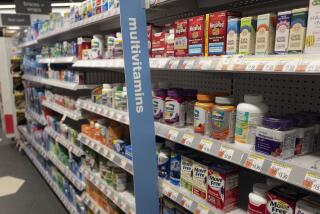Antioxidants: Have they been hyped?
A decade ago, antioxidants -- nutrients such as beta carotene and vitamins C and E -- were taking the nutrition world by storm. These free-radical fighters, medical experts predicted, would extend human life by protecting us from environmental hazards, cancer and heart disease.
Antioxidants began making headlines in the early 1990s, when several large medical studies showed lower rates of cancer in people who took vitamin E and beta carotene. Seemingly overnight, antioxidants were hailed by scientists and the media as an important medical breakthrough. Vitamin E, proclaimed a Time magazine article, was a “potent lung saver.” A story in U.S. News & World Report heralded beta carotene as a “miracle vitamin.”
For the record:
12:00 a.m. Oct. 31, 2003 For The Record
Los Angeles Times Friday October 31, 2003 Home Edition Main News Part A Page 2 National Desk 2 inches; 59 words Type of Material: Correction
Antioxidants -- An article in Monday’s Health section misstated the comments of Dr. Mark Penn of the Cleveland Clinic in Ohio about clinical research into antioxidant supplements. The story incorrectly said that Penn called primary prevention studies examining antioxidant use in healthy people a flawed research method. In fact, Penn was talking about secondary prevention studies involving unhealthy people.
For The Record
Los Angeles Times Monday November 03, 2003 Home Edition Health Part F Page 8 Features Desk 1 inches; 60 words Type of Material: Correction
Antioxidants -- A story in last Monday’s Health section misstated the comments of Dr. Mark Penn of the Cleveland Clinic in Ohio about clinical research into antioxidant supplements. The story incorrectly said that Penn called primary prevention studies examining antioxidant use in healthy people a flawed research method. In fact, Penn was talking about secondary prevention studies involving unhealthy people.
The problem was, much of the research on which these claims were based was preliminary -- the result of test tube or animal experiments that didn’t always pan out when scientists tried to replicate them in humans. And it wasn’t long before those breathless proclamations became more measured.
The reason: In recent years, several larger research studies have found that people who took antioxidant supplements received no greater protection from chronic diseases than those who didn’t. The scientific community remains split on the potential for antioxidant supplements. But one thing is clear: They no longer are considered the miracle cure they once were.
That message, however, appears not to have been fully digested by the public. About one-third of Americans take antioxidants, according to national statistics, and sales of these supplements are rising. Food companies continue to cash in on the antioxidant craze with an array of products, from pomegranate juice to blueberry tea to supplement-spiked fruit smoothies.
Experts say the scientific community must bear part of the blame for raising -- and then dampening -- the public’s hopes about the health benefits of antioxidants.
“The medical community has given the public mixed signals on antioxidants and vitamins,” said Dr. Marc Penn, a cardiologist at the Cleveland Clinic in Ohio who led a recent review of antioxidant research published in the British medical journal Lancet. He found that even his patients seemed to put too much faith in antioxidants. “They felt like, ‘I’m on vitamin E, I’m going to be OK,’ ” he said.
Where did the science go wrong? An oversimplified interpretation of the science that led to misguided dietary advice is one explanation, said Marion Nestle, a professor and chairwoman of New York University’s department of nutrition and food studies. “Researchers said, ‘We know fruits and vegetables are good, so something in them must be good. It must be the antioxidants,’ ” Nestle said. The scrutiny that followed involved numerous studies that looked at antioxidants in isolation -- first in animals, then in humans -- but provided results that were inconsistent at best.
In the lab, antioxidants, including vitamin E and beta carotene, neutralized some of the potentially hazardous byproducts of cell metabolism. As cells convert food to energy, they generate charged molecules known as free radicals, which become neutralized by binding to other charged molecules. Many scientists believe that when free radicals bind to cellular structures such as DNA, it causes damage that can lead to cancer, some chronic diseases and symptoms of advancing age. Round up the free radicals with antioxidants, the theory went, and disease risks would decline.
Lab and animal studies are quick and easy to do, but they don’t offer real proof of what a drug or vitamin may do for a human. Evidence from human studies took much longer to produce.
When research from large-scale human trials began to emerge in the mid-1990s, the results were mixed. Observational studies, in which researchers compared people who took antioxidants or consumed them in their diets with people who didn’t, found lower rates of heart disease and cancer among antioxidant takers. But some researchers said these studies were flawed because of the so-called healthy-user effect. That is, people with lots of antioxidants in their diets may be healthier to begin with, because they may eat low-fat foods or exercise regularly.
“There are loads of studies that show that people taking supplements feel better,” Nestle said. “People taking them are also healthier; they have healthier lifestyles.”
To help resolve the healthy-user question, researchers designed studies in which people of varied health were randomly assigned to take antioxidants. But for every clinical trial that showed some benefit from taking antioxidants, such as lowered cancer rates or decreased risk of heart attack, another found no benefits.
A 1993 study of nearly 30,000 Chinese adults found that people who took antioxidant supplements were less likely to die of cancer. Last year, however, the Lancet published a study of more than 20,000 British adults that showed no difference in heart attack, stroke or cancer rates between people who took antioxidant supplements and those who took placebo pills.
Some of the news was worse: Antioxidants might even harm your health. Two studies in the mid-1990s that looked at beta carotene use concluded that the substance increased smokers’ likelihood of developing lung cancer.
Then, in separate reports released in June, scientists at the U.S. Preventive Services Task Force and the Cleveland Clinic, after reviewing some of the biggest studies to date, concluded that there was insufficient evidence to show antioxidant use did any good. Beta carotene came in for a particularly harsh assessment: The task force said beta carotene supplements should not be used to protect against cancer or heart disease. And the Cleveland Clinic researchers recommended that further studies of beta carotene be stopped.
“We were very concerned about the number of patients and doctors who felt that they were really doing something good by taking antioxidants,” said Penn of the Cleveland Clinic.
But Penn’s findings puzzled other researchers such as Dr. Jeffrey Blumberg, an antioxidant researcher at Tufts University who called the Cleveland Clinic report “stunning” and said it drew conclusions prematurely.
Blumberg, director of Tufts’ Human Nutrition Research Center on Aging, said much of the evidence that failed to show a benefit from antioxidants -- the evidence reviewed by Penn and colleagues -- came from secondary prevention studies in which supplements were given to people with established heart disease or at high risk of heart attacks or cancer (such as smokers).
Primary prevention studies, in which people are put on antioxidants long before they have signs of chronic disease, although preferable are more difficult to do because they require decades of data.
Penn said primary prevention studies -- which examined antioxidant use in healthy people -- were a flawed approach in this case. In the animal studies that first illuminated the potential of vitamin E and beta carotene, he said, researchers gave the compounds to young animals well before chronic disease set in.
“It’s the equivalent of putting vitamin E in [McDonald’s] Happy Meals,” so children can get the vitamin starting at age 5 or 6, Penn said.
Penn and many other researchers still believe that antioxidants are an important part of a healthful diet. But whether those benefits are derived from antioxidants in foods you eat or in supplements is unresolved.
“What we’re looking at is the importance of a healthful diet,” said Melanie Polk, director of nutrition education at the American Institute of Cancer Research in Washington. “We’re not just eating nutrients independently in food. We don’t just eat folic acid, vitamin E or selenium, but a whole arsenal of nutrients” at once, she said. “Green beans, broccoli [and] cauliflower may all contain cancer-protective substances. But broccoli alone is not going to do it.”
Researchers recently have begun to focus on the synergy exhibited when several antioxidants and other phytochemicals -- plant chemicals such as quercetin (found in apples), lycopene (in tomatoes) and sulforaphane (in broccoli) -- act together, said Dr. Michael Aviram, a researcher at the Technion-Israel Institute of Technology in Haifa, Israel. His research has shown that vitamin E amplifies the antioxidant effects of nutrients found in pomegranates.
Will bigger and better studies validate the early predictions about the power of antioxidants? That remains to be seen. Long-term studies still are investigating the effects of antioxidants in isolation, in concert with each other and with other phytochemicals.
To overcome the limitations of earlier studies, some researchers are looking at younger groups. A recent small study, published in the Sept. 2 issue of the medical journal Circulation, showed that vitamin E and C supplements helped improve the cardiovascular health of children with high cholesterol who also were placed on healthier diets.
For now, many doctors and scientists agree that you’re better off consuming antioxidants in their natural form -- by eating fruits and vegetables -- than by taking a vitamin pill. “You can’t get around it,” said Polk. “We should be spending our money in the produce department, not the vitamin aisle.”
*
(BEGIN TEXT OF INFOBOX)
Doing good or doing harm?
Some studies suggest that antioxidants, which occur naturally in many foods, may prevent or slow the development of cancer and help ward off other diseases by protecting cells against damage by oxygen molecules called free radicals. Other studies suggest, however, that there may be little benefit and that antioxidant supplements -- particularly when taken in large doses -- actually may increase cancer risk in some cases. Until more long-term studies are done, many scientists recommend getting antioxidants primarily from foods.
Antioxidant: Vitamin A/beta carotene
Possible benefits: Important in vision, bone growth, reproduction, regulating immune system and reducing risk of some types of cancers.
Possible risks: In excess, might enhance the risk of lung cancer or osteoporosis.
*
Antioxidant: Vitamin E
Possible benefits: May help thwart heart disease, certain cancers, cataracts
Possible risks: Few known risks; extremely high doses may increase bleeding risk.
*
Antioxidant: Selenium
Possible benefits: May combat lung, colorectal and prostate cancers; heart disease and arthritis; may slow progression of HIV/AIDS.
Possible risks: Gastrointestinal upset, hair loss, mild nerve damage.
*
Antioxidant: Coenzyme Q10
Possible benefits: BTD Evidence suggests it stimulates immune system; may be useful as adjuvant therapy for cancer.
Possible risks: No serious side effects; possible insomnia, abdominal pain; Researchers studying interactions with drugs.
*
Antioxidant: Vitamin C
Possible benefits: Possible anti-cancer agent; may help ward off colds.
Possible risks: Doses larger than 2,000 milligrams daily may cause headaches, diarrhea, nausea, heartburn, stomach cramps, possible kidney stones.
*
Sources: National Institutes of Health; National Cancer Institute -- Researched by Times graphics reporter Joel Greenberg.






